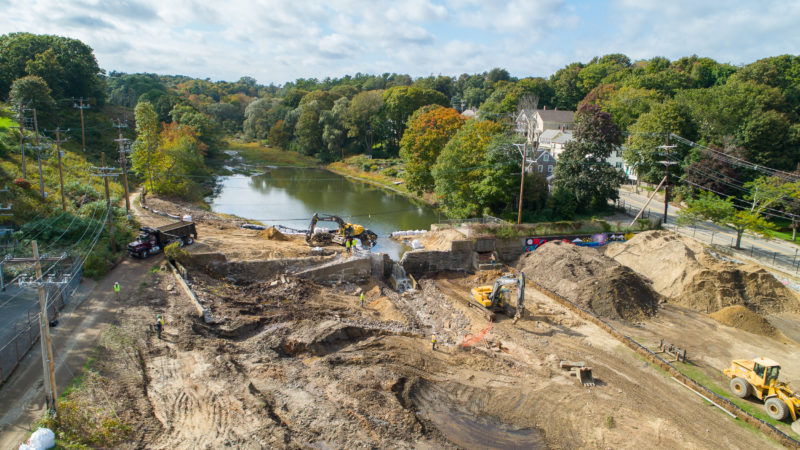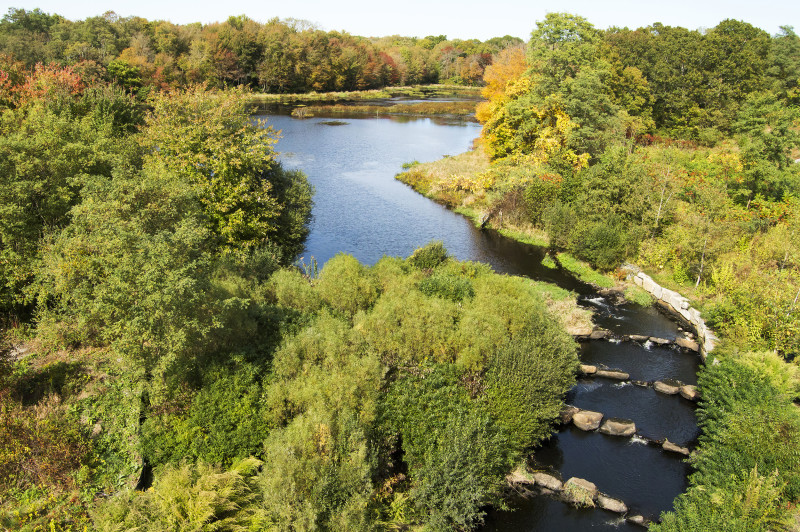Rejuvenation of Plymouth’s Town Brook a model for regional river restoration
Every spring, tens of thousands of river herring in Plymouth’s Town Brook have hit a roadblock less than half a mile upstream from the waters of Cape Cod Bay. These fish, in the midst of their annual migration from the ocean, were being slowed down by a narrow, 300-foot fish ladder through an unused dam — just one of seven man-made barriers that once blocked the river.
But this year, river herring and other migratory fish will be able to swim freely through all 1.7 miles of Town Brook again, for the first time in over 300 years.
Town Brook joins a host of waterways in Southeastern Massachusetts that are demonstrating the positive impact of removing dams to rejuvenate local rivers. The restoration of Town Brook is yet another powerful example of how helping river herring helps the environment as a whole.
David Gould, Plymouth’s director of the Department of Marine and Environmental Affairs, presented on the Town Brook restoration in February at the Westport Fishermen’s Association’s annual Oyster Stew Supper, which is continuing under the Coalition’s leadership. Attendees were interested to learn how the lessons of Town Brook could be applied in Westport, where river herring populations are at historic lows.
River herring are small, silvery fish that form an important foundation in Buzzards Bay’s food web. Many of the Bay’s large sportfish and water birds – including bluefish, striped bass, and ospreys – rely on river herring as food. Rich historic populations of river herring are known for providing food and fertilizer to Native Americans and English settlers. Town Brook and its fish famously sustained the Pilgrims after the Mayflower landed at Plymouth in 1620. But over the past century, river herring populations up and down the East Coast have collapsed.

The former Off Billington Street dam is one of seven man-made barriers that once blocked river herring from swimming upstream. (Image: David Gould)
Dams are one of the biggest problems facing migratory fish like river herring. Left behind by hundreds of years of industry, these obstructions cut across rivers and stop fish in their tracks when they’re trying to swim upstream to spawn. For years, employees and volunteers with the National Oceanic and Atmospheric Administration would actually scoop herring out of Town Brook during the spring migration and drive them by truck to their spawning areas.
This all began to change in 1999, when the town considered putting a fish ladder at the Billington Street dam. Town officials soon realized that it would better serve migratory fish to remove the dam altogether.
For Gould, the restoration of Town Brook is the culmination of nearly two decades of work. The removal of the Billington Street dam in 2002 set off a domino effect — especially when Gould’s team found that 94% of fish who reached this restored section of the river successfully swam through, but only 6% crossed the next dam upstream.
“Everyone involved knew the project would work. But to actually get data to show that fish were getting through the restored section quite easily was really rewarding, and made us want to do more,” Gould said. “That data told us we needed to get the next two dams out so that the fish could make it all the way up.”

Holmes Dam, located about a half-mile upstream from the waters of Cape Cod Bay, was the last obstruction to be removed from Town Brook in fall 2018. (Image: Hawk Visuals)
The restoration of the river at Billington Street was followed by the removal of the Off Billington Street dam and the PlymCo dam, a private property that the town purchased for conservation. Gould’s team then removed a weir at the river’s head of tide. This year, the town is completing the restoration of Town Brook with the removal of Holmes Dam and the restoration of the nearby Newfield Street Bridge.
Already, the positive effects on Town Brook have been striking. River herring have been making it further and further up the river with each passing year, as have other fish like eels and rainbow smelt. Osprey have begun visiting its waters again, and a few weeks ago, a pair of river otters visited Town Brook for the first time in recent memory.
Removing obstructions has also lowered the temperature of the river to its natural cold-water state, which will make the river more resilient to climate change.

At The Sawmill on the Acushnet River, the Coalition worked with NOAA to improve passage for river herring migrating upstream to spawn.
Back here on Buzzards Bay, local efforts to restore the Acushnet River closely mirror the restoration of Plymouth’s Town Brook. The most notable river restoration project took place at the Coalition’s Acushnet Sawmill, where an innovative fishway replaced a dam left over from an industrial lumber mill. The Acushnet River is now the only major river on Buzzards Bay that’s unbroken: fish can swim all the way from the Bay to the fresh waters of the old New Bedford Reservoir. As a result of these restoration efforts, the river’s herring population has increased dramatically in the past decade.
With The Sawmill as our model, the Coalition has begun the process to restore fish passage on the Weweantic River at Horseshoe Mill, the site of a crumbling dam that blocks fish from migrating up Buzzards Bay’s largest freshwater river.
Similar to The Sawmill, Gould’s team is currently working on rebuilding a park around the site of the former Holmes Dam, with Town Brook as its centerpiece. Gould explained: “Freeing passage for river herring may have been the main reason for construction, but we’re also trying at the same time to build that connection for people to the river.”
For more information about the Town Brook restoration, view Gould’s presentation from the Westport Fishermen’s Association Oyster Stew Supper:
BBC Presentation_David Gould